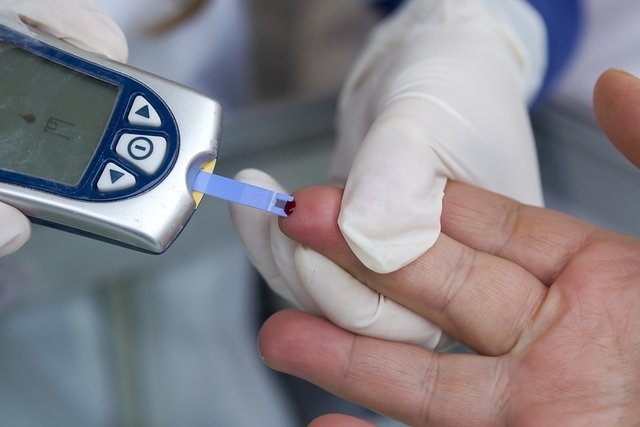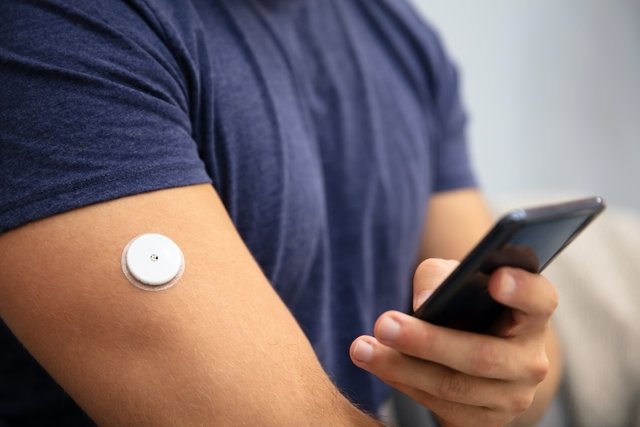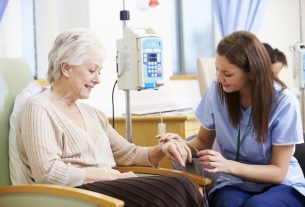Glycemia is the term that refers to the amount of glucose, better known as sugar, in the blood that arrives through the intake of foods containing carbohydrates, such as cake, pasta and bread, for example. The concentration of glucose in the blood is controlled by two hormones, insulin, which is responsible for reducing sugar in the bloodstream, and glucagon, which functions to increase glucose levels.
There are several ways to measure blood glucose levels through blood tests, such as fasting blood glucose and glycated hemoglobin, or through easy-to-use blood glucose meters and devices that the person can use themselves.
Blood glucose reference values should ideally be between 70 and 100 mg/dL on an empty stomach and when it is below this value it indicates hypoglycemia, which causes symptoms such as drowsiness, dizziness and even fainting. Hyperglycemia is when blood glucose is above 100 mg/dL on an empty stomach and may indicate type 1 or type 2 diabetes, which if not controlled can cause complications, such as vision problems and diabetic foot. Learn about other symptoms of diabetes.

How is blood glucose measured
Blood glucose refers to the concentration of glucose in the blood and can be measured in several ways, such as:
1. Capillary blood glucose
Capillary blood glucose is an exam that is performed by pricking a finger and then analyzing a drop of blood on a strip connected to a device called a glucometer. Currently, there are several models of different brands of glucometer, they are available for sale in pharmacies and can be carried out by anyone, as long as they are provided with prior guidance.
This type of exam allows people with diabetes to have greater control over blood glucose levels, preventing episodes of hypoglycemia due to the use of insulin, helping to understand how food, stress, emotions and physical exercise change blood levels. blood glucose and also helps to define the correct dose of insulin to be administered. See how to measure capillary blood glucose.
2. Fasting blood glucose
Fasting blood glucose is a blood test performed to check blood glucose levels and must be done after a period without eating or drinking, except water, for at least 8 hours or as directed by your doctor.
This test helps the general practitioner or endocrinologist to diagnose diabetes, however, more than one sample must be collected and it may be recommended to carry out more tests, such as glycated hemoglobin, for the doctor to confirm the diagnosis of diabetes. Fasting blood glucose can also be performed for your doctor to assess whether diabetes treatment is effective or to monitor other health problems that alter blood glucose levels.
3. Glycated hemoglobin
Glycated hemoglobin, or HbA1c, is a blood test carried out to evaluate the amount of glucose linked to hemoglobin, a component of red blood cells, and refers to the blood glucose history over 120 days, as this is the period of life of the red blood cell and the time it is exposed to sugar, forming glycated hemoglobin, and this test is the most used method to diagnose diabetes.
Normal glycated hemoglobin reference values should be less than 5.7%, however, in some cases, the glycated hemoglobin result may be altered due to some factors, such as anemia, drug use and blood diseases, for example. Before carrying out the exam, the doctor will analyze the person’s health history.
4. Glycemic curve
The glycemic curve, also known as glucose tolerance test, consists of a blood test in which fasting blood glucose is checked and 2 hours after ingesting 75 g of glucose by mouth. In the 3 days before the exam, the person needs to eat a diet rich in carbohydrates, such as bread and cakes, for example, and then fast for 12 hours.
Furthermore, it is important that before taking the exam the person has not drunk coffee or smoked for at least 24 hours. After the first blood sample is collected, the person will ingest glucose and then rest so that blood can be collected again in 2 hours. After the test, the result takes between 2 and 3 days to be ready, depending on the laboratory and normal values must be below 100 mg/dL on an empty stomach and 140 mg/dL after ingesting 75g of glucose. Better understand the result of the glycemic curve.
5. Postprandial blood glucose
Postprandial glycemia is a test to identify blood glucose levels between 1 and 2 hours after a person has eaten a meal and is used to assess hyperglycemia peaks, associated with cardiovascular risk or a problem with insulin release. Generally, this type of test is recommended by a general practitioner or endocrinologist to complement the fasting blood glucose test and normal values must be below 140 mg/dL.
6. Blood glucose sensor on the arm
Currently, there is a sensor to check blood glucose that is implanted in a person’s arm and allows checking blood glucose levels without needing to prick the finger. This sensor is a round device with a very thin needle that is inserted into the back of the arm, does not cause pain or discomfort, and is widely used even for diabetic children, as it reduces the discomfort of having to prick their finger.
In this case, to measure blood glucose, simply bring your cell phone, or a brand-specific device, close to the sensor on your arm and then the scan will be carried out and the result will appear on the cell phone screen. The sensor must be changed every 14 days, but it is not necessary to carry out any type of calibration, unlike a common capillary blood glucose device.

What is it for
Blood glucose testing is recommended by a general practitioner or endocrinologist to check blood glucose levels and through this, certain diseases and conditions can be detected, such as:
- Diabetes type 1;
- Type 2 diabetes;
- Gestational diabetes;
- Insulin resistance;
- Thyroid changes;
- Pancreas diseases;
- Hormonal problems.
Blood glucose control can also complement the diagnosis of Dumping syndrome, for example, which is a condition in which food passes quickly from the stomach to the intestine, leading to the appearance of hypoglycemia and causing symptoms such as dizziness, nausea and tremors. Learn more about Dumping syndrome.
Often, this type of analysis is carried out as a routine hospital procedure on people who are hospitalized and who receive serum with glucose or use intravenous medication that can cause blood sugar levels to drop a lot or rise quickly.
What are the reference values
The tests to check capillary blood glucose are diverse and may vary according to the laboratory and tests used, but the results should generally have values as shown in the table below:
After checking the results of the test, the doctor will analyze the symptoms presented by a person and may recommend other tests to check the possible causes of low or high blood sugar. To better understand the results of your glucose test, enter your results into the calculator below:
1. Low blood sugar
Low blood glucose, also called hypoglycemia, is a decrease in blood glucose levels, identified by values below 70 mg/dL. The symptoms of this condition can be dizziness, cold sweat, nausea, which can lead to fainting, mental confusion and coma if not reversed in time, and this can be caused by the use of medication or the use of insulin in very high doses. See more about what can cause hypoglycemia.
What to do: Hypoglycemia must be treated quickly, so if a person experiences milder symptoms, such as dizziness, they should be offered a juice box or something sweet immediately. In the most serious cases, in which mental confusion and fainting occur, it is necessary to call the SAMU ambulance or take the person to an emergency room, and only offer sugar if the person is conscious.
2. High blood sugar
High blood glucose, better known as hyperglycemia, occurs when blood sugar levels are very high due to the intake of very sweet and carbohydrate-based foods, which can cause diabetes. This change normally does not cause symptoms, however, in cases where blood glucose is very high and for a long time, dry mouth, headache, drowsiness and frequent urge to urinate may appear. Find out why hyperglycemia happens.
What to do: nIn cases where diabetes is already diagnosed, the doctor usually recommends the use of hypoglycemic medications, such as metformin, and injectable insulin. Furthermore, in some cases hyperglycemia can be reversed through dietary changes, reducing the consumption of foods rich in sugar and pasta and by performing physical activities regularly.

Sign up for our newsletter and stay up to date with exclusive news
that can transform your routine!
Warning: Undefined array key "title" in /home/storelat/public_html/wp-content/plugins/link-whisper-premium/templates/frontend/related-posts.php on line 12
Warning: Undefined array key "title_tag" in /home/storelat/public_html/wp-content/plugins/link-whisper-premium/templates/frontend/related-posts.php on line 13



